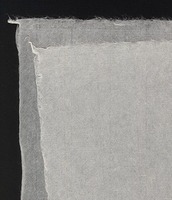Rare Books: A Glossary
Jobbing — Lithography
Jobbing: A term for small, quick side-projects undertaken by printers, typically ephemeral in nature. The term is short for “job printing” and was a staple of printing for much of its history. It was often used by printers to earn money to pay bills and finance other, larger projects. Gutenberg himself undertook job printing, printing papal indulgences in 1454 even before he completed the first printed Bible.
Kozo paper: A kind of Japanese paper made of mulberry fibers. Kozo paper is popular among book restorers because it is very strong and can be used to reinforce damaged paper, especially in the spine.
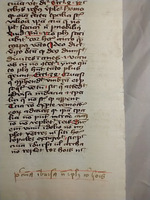
Laid paper: Paper that demonstrates chain lines and wire lines. It is typically handmade. Chain lines and wire lines are traces left by the papermaker’s mold and are commonly visible when light shines through the paper. They are very useful in determining the format of a book, as they can give some impression of how the paper sheet was folded.
Image: Leaf from the Sermones of Simon de Cremona. Buxheim: Caspar Misnensis, 1434. Z113 .P3 Box 1, FF 5
Laid paper: Paper that demonstrates chain lines and wire lines. It is typically handmade. Chain lines and wire lines are traces left by the papermaker’s mold and are commonly visible when light shines through the paper. They are very useful in determining the format of a book, as they can give some impression of how the paper sheet was folded.
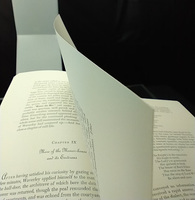
Leaf: The basic unit of a codex book, i.e., a piece of paper with a page on either side. In most bindings, a leaf is made by folding a sheet of paper one or more times, producing another pair of leaves with each fold. Two leaves that are connected through the fold are conjugate with one another; if a leaf’s conjugate has been removed, it will often leave a visible stub in a book. Single leaves (especially from very old books) are often sold individually.
Image: Scott, Walter, 1771-1832. Waverley. New York: Printed for the members of the Limited Editions Club, 1961. PR5322 .W4 1961
Leaf: The basic unit of a codex book, i.e., a piece of paper with a page on either side. In most bindings, a leaf is made by folding a sheet of paper one or more times, producing another pair of leaves with each fold. Two leaves that are connected through the fold are conjugate with one another; if a leaf’s conjugate has been removed, it will often leave a visible stub in a book. Single leaves (especially from very old books) are often sold individually.

Leather: A tanned animal skin and a popular binding material. The most common animal skins used for bookbinding leather are cow, goat, sheep, and pig. Sometimes skins would be prepared with alum salts, in which case they are said to be “tawed” rather than “tanned”, resulting in a tougher but less flexible material; tawed pigskin was popular among medieval German binders. Different kinds of leather often have fancy names based on their color or historical origins. If the skin is not tanned or tawed, but is instead stretched and scraped thin, then you are dealing with parchment.
Image:
Leather: A tanned animal skin and a popular binding material. The most common animal skins used for bookbinding leather are cow, goat, sheep, and pig. Sometimes skins would be prepared with alum salts, in which case they are said to be “tawed” rather than “tanned”, resulting in a tougher but less flexible material; tawed pigskin was popular among medieval German binders. Different kinds of leather often have fancy names based on their color or historical origins. If the skin is not tanned or tawed, but is instead stretched and scraped thin, then you are dealing with parchment.
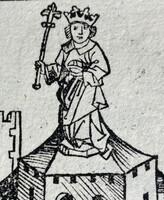
Librarian: A person who maintains a collection of books and other research materials. While librarians can become bellicose if their collections or patrons are mistreated, they are otherwise irenic and magnanimous. Some librarians, particularly those who engage in definition, are pleonastic whereas others are more succinct. Oddly, few librarians have much time to read.
Image: Schedel, Hartmann, 1440-1514. Liber chronicarum. Nürnberg: Anton Koberger, 1493. Z241 .S3 1493A
Librarian: A person who maintains a collection of books and other research materials. Oddly, few librarians have much time to read.
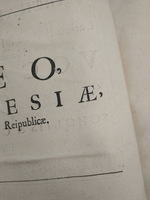
Ligature: A single character that combines multiple letters. Ligatures were initially invented by scribes but were taken up in printing both to imitate handwriting and to utilize space efficiently. The character “æ,” for instance, is a combination of the letters “a” and “e,” which is sometimes used as a fancy way of spelling words like “encyclopædia” and sometimes as a letter in its own right (as in Old English). Most ligatures have fallen away over the centuries, as they required custom-made type and it was simpler to just use letters individually. The most commonly used ligature today is probably the ampersand (&) symbol, which combines the letters “e” and “t” to abbreviate the Latin word “et” into one character.
Image: Spelman, Henry, Sir, 1564?-1641. Glossarium archaiologicum : continens latino-barbara, peregrina, obsoleta, & novatæ significationis vocabula. London: Printed by Thomas Braddyll & sold by George Pawlett & William Freeman, 1687. PA2889 .S7 1687
Ligature: A single character that combines multiple letters. Ligatures were initially invented by scribes but were taken up in printing both to imitate handwriting and to utilize space efficiently. The character “æ,” for instance, is a combination of the letters “a” and “e,” which is sometimes used as a fancy way of spelling words like “encyclopædia” and sometimes as a letter in its own right (as in Old English). Most ligatures have fallen away over the centuries, as they required custom-made type and it was simpler to just use letters individually. The most commonly used ligature today is probably the ampersand (&) symbol, which combines the letters “e” and “t” to abbreviate the Latin word “et” into one character.
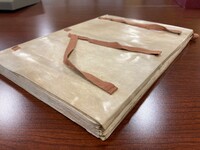
Limp binding: A binding without boards. Limp bindings were often done using vellum or manuscript waste.
Image: Reynard the Fox. English. Hammersmith: Kelmscott Press, sold by B. Quaritch, London, 1893. PT5584 .E5 C33 1893
Limp binding: A binding without boards. Limp bindings were often done using vellum or manuscript waste.
![Joan of Arc saved France [graphic] : women of America save your country : buy War Savings Stamps / Haskell Coffin. Joan of Arc saved France [graphic] : women of America save your country : buy War Savings Stamps / Haskell Coffin.](https://library.missouri.edu/specialcollections/files/thumbnails/3ad87b8329a59f92671d3b071ab6d5fe.jpg)
Lithography: An illustration process invented in 1798 by Alois Senefelder that is neither intaglio nor relief. Lithography involves writing on a flat surface with a grease-crayon and then applying an acid solution to slightly etch the non-drawn surfaces. The entire surface is then covered in water, which does not lie on the greasy marks (as water and grease repel one another). A greasy printing ink is then applied, which only settles on the greasy drawing, and can then be printed. Lithography can be done using special limestones or using metal plates. It allows color printing in a way that previous illustration techniques did not and is still practiced by artists today.
Image: Coffin, Haskell, 1878-1941. Joan of Arc saved France: women of America save your country. New York: United States Printing & Lithographic Co., 1918?. D522.25 .C64 1918. Digitally available at the MU Digital Library.
Lithography: An illustration process invented in 1798 by Alois Senefelder that is neither intaglio nor relief. Lithography involves writing on a flat surface with a grease-crayon and then applying an acid solution to slightly etch the non-drawn surfaces. The entire surface is then covered in water, which does not lie on the greasy marks (as water and grease repel one another). A greasy printing ink is then applied, which only settles on the greasy drawing, and can then be printed. Lithography can be done using special limestones or using metal plates. It allows color printing in a way that previous illustration techniques did not and is still practiced by artists today.
